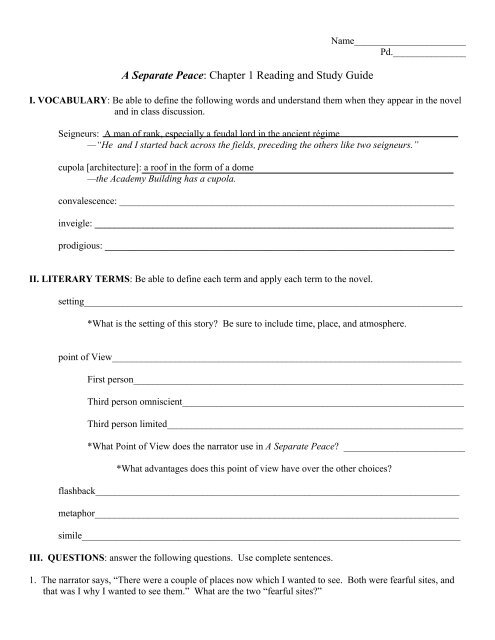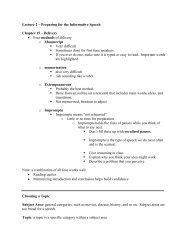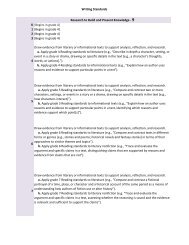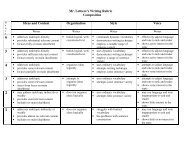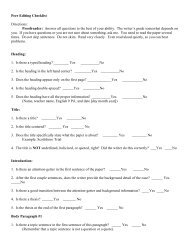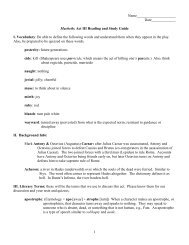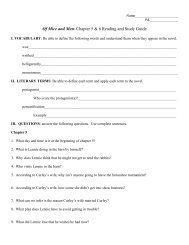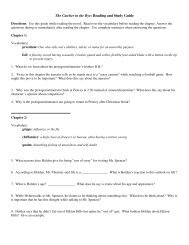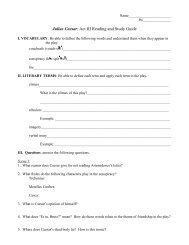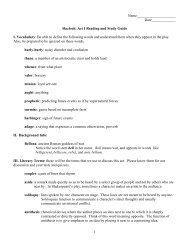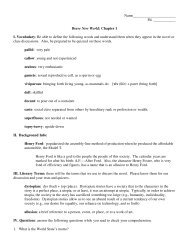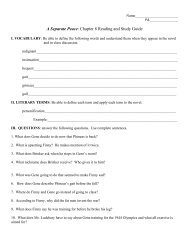A Separate Peace: Chapter 1 Reading and Study Guide
A Separate Peace: Chapter 1 Reading and Study Guide
A Separate Peace: Chapter 1 Reading and Study Guide
You also want an ePaper? Increase the reach of your titles
YUMPU automatically turns print PDFs into web optimized ePapers that Google loves.
A <strong>Separate</strong> <strong>Peace</strong>: <strong>Chapter</strong> 1 <strong>Reading</strong> <strong>and</strong> <strong>Study</strong> <strong>Guide</strong>Name_______________________Pd._______________I. VOCABULARY: Be able to define the following words <strong>and</strong> underst<strong>and</strong> them when they appear in the novel<strong>and</strong> in class discussion.Seigneurs: A man of rank, especially a feudal lord in the ancient régime—“He <strong>and</strong> I started back across the fields, preceding the others like two seigneurs.”cupola [architecture]: a roof in the form of a dome—the Academy Building has a cupola.convalescence: _____________________________________________________________________inveigle: __________________________________________________________________________prodigious: ________________________________________________________________________II. LITERARY TERMS: Be able to define each term <strong>and</strong> apply each term to the novel.setting______________________________________________________________________________*What is the setting of this story? Be sure to include time, place, <strong>and</strong> atmosphere.point of View________________________________________________________________________First person____________________________________________________________________Third person omniscient__________________________________________________________Third person limited_____________________________________________________________*What Point of View does the narrator use in A <strong>Separate</strong> <strong>Peace</strong>? _________________________*What advantages does this point of view have over the other choices?flashback___________________________________________________________________________metaphor___________________________________________________________________________simile______________________________________________________________________________III. QUESTIONS: answer the following questions. Use complete sentences.1. The narrator says, “There were a couple of places now which I wanted to see. Both were fearful sites, <strong>and</strong>that was I why I wanted to see them.” What are the two “fearful sites?”
2. Where is everyone when the narrator first returns to the school?3. The narrator says, “I had overlooked [. . .] crucial fact.” What is the “crucial fact” about the marble stairsthat the narrator overlooked?4. What was the field house called?5. The narrator says, “[The tree] loomed in my memory as a huge lone spike dominating the riverbank,forbidding as an artillery piece.” What literary device is the narrator/author using in this passage? What isits significance?6. The narrator says, “The tree was tremendous, an irate, steely black steeple beside the river.” What literarydevice he is using? What is its significance?7. What will be the name of the narrator <strong>and</strong> Phineas’s class when they start in the fall?8. Where did the idea of jumping from the tree originate? The senior class had to do it as part of war training.9. Why was the Summer Session established?10. What physical similarity does the narrator <strong>and</strong> Phineas have?11. What is Elwin Lepellier’s nickname? What does his nickname mean?12. What choice does Elwin make about jumping from the tree?IV. Passages: the following passages might prove to be important. Re-read the sections with these passages<strong>and</strong> think about why they might be significant? What do they mean? What are important ideas, imagery, orwords? How do they add or detract from the story? Do they incorporate any literary devices?“Finny trapped me again in his strongest trap, that is, I suddenly became his collaborator. As we walkedrapidly along I abruptly resented the bell <strong>and</strong> my West Point stride <strong>and</strong> hurrying <strong>and</strong> conforming. Finnywas right. And there was only one way to show him this. I threw my hip against his, catching him bysurprise, <strong>and</strong> he was instantly down, definitely pleased. [. . .] When I jumped on top of him, my knees onhis chest, he couldn’t ask for anything better. We struggled in some equality.”V. Close <strong>Reading</strong>: authors sometimes incorporate motif in their writing. One might argue that a motif of thisbook is war. Below provide quotes <strong>and</strong> page numbers of words <strong>and</strong> phrases that seemed borrowed from war.Example: “torpedo the troopship” (9) – Phineas says this to the narrator to get him to jump.“counterattack” (11) – the narrator uses this to describe the playful fighting between him <strong>and</strong> Finny.


